Thunderstorms & Lightning
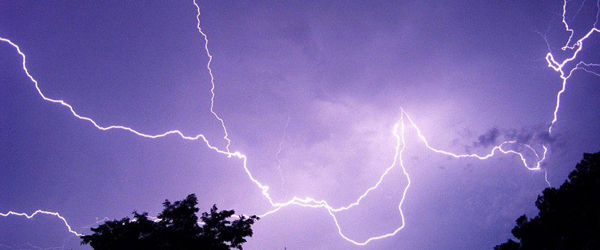 All thunderstorms are dangerous. Every thunderstorm produces lightning. While lightning fatalities have decreased over the past 30 years, lightning continues to be one of the top three storm-related killers in the United States. In 2010 there were 29 fatalities and 182 injuries from lightning. Although most lightning victims survive, people struck by lightning often report a variety of long-term, debilitating symptoms.
All thunderstorms are dangerous. Every thunderstorm produces lightning. While lightning fatalities have decreased over the past 30 years, lightning continues to be one of the top three storm-related killers in the United States. In 2010 there were 29 fatalities and 182 injuries from lightning. Although most lightning victims survive, people struck by lightning often report a variety of long-term, debilitating symptoms.
Other associated dangers of thunderstorms include tornadoes, strong winds, hail and flash flooding. Flash flooding is responsible for more fatalities – more than 140 annually – than any other thunderstorm-associated hazard. Dry thunderstorms that do not produce rain that reaches the ground are most prevalent in the western United States. Falling raindrops evaporate, but lightning can still reach the ground and can start wildfires.
Before Thunderstorm and Lightning
To prepare for a thunderstorm, you should do the following:
- To begin preparing, you should build an emergency kit and make a family communications plan.
- Remove dead or rotting trees and branches that could fall and cause injury or damage during a severe thunderstorm.
- Postpone outdoor activities.
- Remember the 30/30 Lightning Safety Rule: Go indoors if, after seeing lightning, you cannot count to 30 before hearing thunder. Stay indoors for 30 minutes after hearing the last clap of thunder.
- Secure outdoor objects that could blow away or cause damage.
- Get inside a home, building, or hard top automobile (not a convertible). Although you may be injured if lightning strikes your car, you are much safer inside a vehicle than outside.
- Remember, rubber-soled shoes and rubber tires provide NO protection from lightning. However, the steel frame of a hard-topped vehicle provides increased protection if you are not touching metal.
- Shutter windows and secure outside doors. If shutters are not available, close window blinds, shades or curtains.
- Unplug any electronic equipment well before the storm arrives.
During Thunderstorms and Lightning
If thunderstorm and lightning are occurring in your area, you should:
- Use your battery-operated NOAA Weather Radio for updates from local officials.
- Avoid contact with corded phones. Use a corded telephone only for emergencies. Cordless and cellular telephones are safe to use.
- Avoid contact with electrical equipment or cords. Unplug appliances and other electrical items such as computers and turn off air conditioners. Power surges from lightning can cause serious damage.
- Avoid contact with plumbing. Do not wash your hands, do not take a shower, do not wash dishes, and do not do laundry. Plumbing and bathroom fixtures can conduct electricity.
- Stay away from windows and doors, and stay off porches.
- Do not lie on concrete floors and do not lean against concrete walls.
- Avoid natural lightning rods such as a tall, isolated tree in an open area.
- Avoid hilltops, open fields, the beach or a boat on the water.
- Take shelter in a sturdy building. Avoid isolated sheds or other small structures in open areas.
- Avoid contact with anything metal—tractors, farm equipment, motorcycles, golf carts, golf clubs, and bicycles.
- If you are driving, try to safely exit the roadway and park. Stay in the vehicle and turn on the emergency flashers until the heavy rain ends. Avoid touching metal or other surfaces that conduct electricity in and outside the vehicle.
After a Thunderstorm or Lightning Strike
If lightning strikes you or someone you know, call 9-1-1 for medical assistance as soon as possible. The following are things you should check when you attempt to give aid to a victim of lightning:
- Breathing - if breathing has stopped, begin mouth-to-mouth resuscitation.
- Heartbeat - if the heart has stopped, administer CPR.
- Pulse - if the victim has a pulse and is breathing, look for other possible injuries. Check for burns where the lightning entered and left the body. Also be alert for nervous system damage, broken bones and loss of hearing and eyesight.
After the storm passes remember to:
- Never drive through a flooded roadway. Turn around, don’t drown!
- Stay away from storm-damaged areas to keep from putting yourself at risk from the effects of severe thunderstorms.
- Continue to listen to a NOAA Weather Radio or to local radio and television stations for updated information or instructions, as access to roads or some parts of the community may be blocked.
- Help people who may require special assistance, such as infants, children and the elderly or those with access or functional needs.
- Stay away from downed power lines and report them immediately.
- Watch your animals closely. Keep them under your direct control.
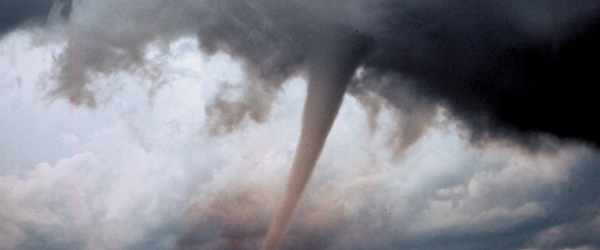 Tornadoes are nature’s most violent storms. Spawned from powerful thunderstorms, tornadoes can cause fatalities and devastate a neighborhood in seconds. A tornado appears as a rotating, funnel-shaped cloud that extends from a thunderstorm to the ground with whirling winds that can reach 300 miles per hour. Damage paths can be in excess of one mile wide and 50 miles long. Every state is at some risk from this hazard. Some tornadoes are clearly visible, while rain or nearby low-hanging clouds obscure others. Occasionally, tornadoes develop so rapidly that little, if any, advance warning is possible. Before a tornado hits, the wind may die down and the air may become very still. A cloud of debris can mark the location of a tornado even if a funnel is not visible. Tornadoes generally occur near the trailing edge of a thunderstorm. It is not uncommon to see clear, sunlit skies behind a tornado.
Tornadoes are nature’s most violent storms. Spawned from powerful thunderstorms, tornadoes can cause fatalities and devastate a neighborhood in seconds. A tornado appears as a rotating, funnel-shaped cloud that extends from a thunderstorm to the ground with whirling winds that can reach 300 miles per hour. Damage paths can be in excess of one mile wide and 50 miles long. Every state is at some risk from this hazard. Some tornadoes are clearly visible, while rain or nearby low-hanging clouds obscure others. Occasionally, tornadoes develop so rapidly that little, if any, advance warning is possible. Before a tornado hits, the wind may die down and the air may become very still. A cloud of debris can mark the location of a tornado even if a funnel is not visible. Tornadoes generally occur near the trailing edge of a thunderstorm. It is not uncommon to see clear, sunlit skies behind a tornado.
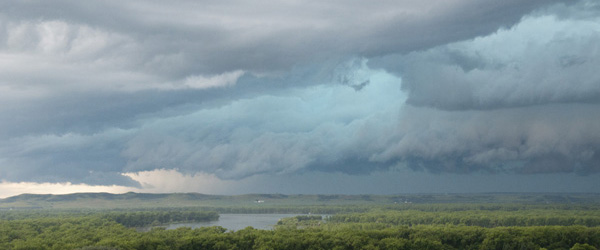 Before a Tornado
Before a Tornado
- To begin preparing, you should build an emergency kit and make a family communications plan.
- Listen to NOAA Weather Radio or to commercial radio or television newscasts for the latest information. In any emergency, always listen to the instructions given by local emergency management officials.
- Be alert to changing weather conditions. Look for approaching storms.
- Look for the following danger signs:
- Dark, often greenish sky
- Large hail
- A large, dark, low-lying cloud (particularly if rotating)
- Loud roar, similar to a freight train.
- If you see approaching storms or any of the danger signs, be prepared to take shelter immediately.
During a Tornado
If you are under a tornado warning, seek shelter immediately! Most injuries associated with high winds are from flying debris, so remember to protect your head. If available, put on a bicycle or motorcycle helmet to protect yourself from head injuries.
| If you are in: | Then: |
|---|---|
| A structure (e.g. residence, small building, school, nursing home, hospital, factory, shopping center, high-rise building) |
|
| A trailer or mobile home |
|
| The outside with no shelter |
|
After a Tornado
Injury may result from the direct impact of a tornado or it may occur afterward when people walk among debris and enter damaged buildings. A study of injuries after a tornado in Marion, Illinois, showed that 50 percent of the tornado-related injuries were suffered during rescue attempts, cleanup and other post-tornado activities. Nearly a third of the injuries resulted from stepping on nails. Because tornadoes often damage power lines, gas lines or electrical systems, there is a risk of fire, electrocution or an explosion. Protecting yourself and your family requires promptly treating any injuries suffered during the storm and using extreme care to avoid further hazards.
Injuries
Check for injuries. Do not attempt to move seriously injured people unless they are in immediate danger of further injury. Get medical assistance immediately. If someone has stopped breathing, begin CPR if you are trained to do so. Stop a bleeding injury by applying direct pressure to the wound. Have any puncture wound evaluated by a physician. If you are trapped, try to attract attention to your location.
General Safety Precautions
Here are some safety precautions that could help you avoid injury after a tornado:
- Continue to monitor your battery-powered radio or television for emergency information.
- Be careful when entering any structure that has been damaged.
- Wear sturdy shoes or boots, long sleeves and gloves when handling or walking on or near debris.
- Be aware of hazards from exposed nails and broken glass.
- Do not touch downed power lines or objects in contact with downed lines. Report electrical hazards to the police and the utility company.
- Use battery-powered lanterns, if possible, rather than candles to light homes without electrical power. If you use candles, make sure they are in safe holders away from curtains, paper, wood or other flammable items. Never leave a candle burning when you are out of the room.
- Never use generators, pressure washers, grills, camp stoves or other gasoline, propane, natural gas or charcoal-burning devices inside your home, basement, garage or camper - or even outside near an open window, door or vent. Carbon monoxide (CO) - an odorless, colorless gas that can cause sudden illness and death if you breathe it - from these sources can build up in your home, garage or camper and poison the people and animals inside. Seek prompt medical attention if you suspect CO poisoning and are feeling dizzy, light-headed or nauseated.
- Hang up displaced telephone receivers that may have been knocked off by the tornado, but stay off the telephone, except to report an emergency.
- Cooperate fully with public safety officials.
- Respond to requests for volunteer assistance by police, fire fighters, emergency management and relief organizations, but do not go into damaged areas unless assistance has been requested. Your presence could hamper relief efforts and you could endanger yourself.
Inspecting the Damage
- After a tornado, be aware of possible structural, electrical or gas-leak hazards in your home. Contact your local city or county building inspectors for information on structural safety codes and standards. They may also offer suggestions on finding a qualified contractor to do work for you.
- In general, if you suspect any damage to your home, shut off electrical power, natural gas and propane tanks to avoid fire, electrocution or explosions.
- If it is dark when you are inspecting your home, use a flashlight rather than a candle or torch to avoid the risk of fire or explosion in a damaged home.
- If you see frayed wiring or sparks, or if there is an odor of something burning, you should immediately shut off the electrical system at the main circuit breaker if you have not done so already.
- If you smell gas or suspect a leak, turn off the main gas valve, open all windows and leave the house immediately. Notify the gas company, the police or fire departments, or State Fire Marshal's office and do not turn on the lights, light matches, smoke or do anything that could cause a spark. Do not return to your house until you are told it is safe to do so.
Safety During Clean Up
- Wear sturdy shoes or boots, long sleeves and gloves.
- Learn proper safety procedures and operating instructions before operating any gas-powered or electric-powered saws or tools.
- Clean up spilled medicines, drugs, flammable liquids and other potentially hazardous materials.
Volcanoes
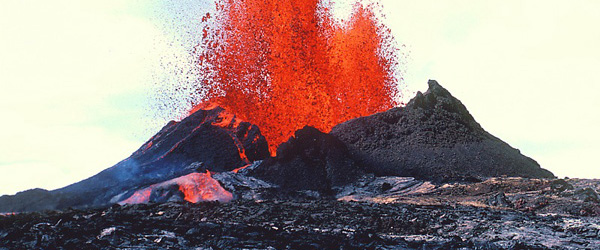 A volcano is a mountain that opens downward to a reservoir of molten rock below the surface of the earth. Unlike most mountains, which are pushed up from below, volcanoes are vents through which molten rock escapes to the earth’s surface. When pressure from gases within the molten rock becomes too great, an eruption occurs. Eruptions can be quiet or explosive. There may be lava flows, flattened landscapes, poisonous gases, and flying rock and ash that can sometimes travel hundreds of miles downwind.
A volcano is a mountain that opens downward to a reservoir of molten rock below the surface of the earth. Unlike most mountains, which are pushed up from below, volcanoes are vents through which molten rock escapes to the earth’s surface. When pressure from gases within the molten rock becomes too great, an eruption occurs. Eruptions can be quiet or explosive. There may be lava flows, flattened landscapes, poisonous gases, and flying rock and ash that can sometimes travel hundreds of miles downwind.
Because of their intense heat, lava flows are great fire hazards. Lava flows destroy everything in their path, but most move slowly enough that people can move out of the way.
Fresh volcanic ash, made of pulverized rock, can be abrasive, acidic, gritty, gassy and odorous. While not immediately dangerous to most adults, the acidic gas and ash can cause lung damage to small infants, to older adults and to those suffering from severe respiratory illnesses. Volcanic ash also can damage machinery, including engines and electrical equipment. Ash accumulations mixed with water become heavy and can collapse roofs. Volcanic ash can affect people hundreds of miles away from the cone of a volcano.
Sideways directed volcanic explosions, known as "lateral blasts," can shoot large pieces of rock at very high speeds for several miles. These explosions can kill by impact, burial or heat. They have been known to knock down entire forests.
Volcanic eruptions can be accompanied by other natural hazards, including earthquakes, mudflows and flash floods, rock falls and landslides, acid rain, fire, and (under special conditions) tsunamis.
Active volcanoes in the U.S. are found mainly in Hawaii, Alaska and the Pacific Northwest. The danger area around a volcano covers approximately a 20-mile radius however some danger may exist 100 miles or more from a volcano.
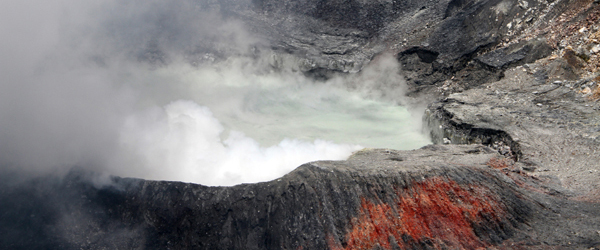 Before a Volcanic Eruption
Before a Volcanic Eruption
The following are things you can do to protect yourself, your family and your property in the event of a volcanic eruption.
- Build an Emergency Supply Kit, which includes items like non-perishable food, water, a battery-powered or hand-crank radio, extra flashlights and batteries. You may want to prepare a portable kit and keep it in your car in case you are told to evacuate. This kit should also include a pair of goggles and disposable breathing masks for each member of the family.
- Make a Family Emergency Plan. Your family may not be together when disaster strikes, so it is important to know how you will contact one another, how you will get back together and what you will do in case of an emergency.
During a Volcanic Eruption
- Follow the evacuation order issued by authorities and evacuate immediately from the volcano area to avoid flying debris, hot gases, lateral blast and lava flow.
- Be aware of mudflows. The danger from a mudflow increases near stream channels and with prolonged heavy rains. Mudflows can move faster than you can walk or run. Look upstream before crossing a bridge and do not cross the bridge if a mudflow is approaching.
- Avoid river valleys and low-lying areas.
- Remember to help your neighbors who may require special assistance - infants, elderly people and people with access and functional needs.
Protection from Falling Ash
After a Volcanic Eruption
- Go to a designated public shelter if you have been told to evacuate or you feel it is unsafe to remain in your home. Text SHELTER + your ZIP code to 43362 (4FEMA) to find the nearest shelter in your area (example: shelter 12345).
- Local authorities may not immediately be able to provide information on what is happening and what you should do. However, you should listen to NOAA Weather Radio, watch TV, listen to the radio or check the Internet often for official news and instructions as they become available.
Tsunamis
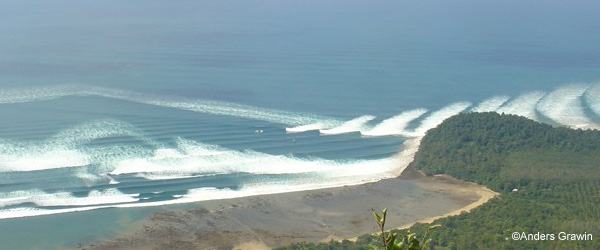 Tsunamis (pronounced soo-ná-mees), also known as seismic sea waves (mistakenly called “tidal waves”), are a series of enormous waves created by an underwater disturbance such as an earthquake, landslide, volcanic eruption, or meteorite. A tsunami can move hundreds of miles per hour in the open ocean and smash into land with waves as high as 100 feet or more.
Tsunamis (pronounced soo-ná-mees), also known as seismic sea waves (mistakenly called “tidal waves”), are a series of enormous waves created by an underwater disturbance such as an earthquake, landslide, volcanic eruption, or meteorite. A tsunami can move hundreds of miles per hour in the open ocean and smash into land with waves as high as 100 feet or more.
From the area where the tsunami originates, waves travel outward in all directions. Once the wave approaches the shore, it builds in height. The topography of the coastline and the ocean floor will influence the size of the wave. There may be more than one wave and the succeeding one may be larger than the one before. That is why a small tsunami at one beach can be a giant wave a few miles away.
All tsunamis are potentially dangerous, even though they may not damage every coastline they strike. A tsunami can strike anywhere along most of the U.S. coastline. The most destructive tsunamis have occurred along the coasts of California, Oregon, Washington, Alaska and Hawaii.
Earthquake-induced movement of the ocean floor most often generates tsunamis. If a major earthquake or landslide occurs close to shore, the first wave in a series could reach the beach in a few minutes, even before a warning is issued. Areas are at greater risk if they are less than 25 feet above sea level and within a mile of the shoreline. Drowning is the most common cause of death associated with a tsunami. Tsunami waves and the receding water are very destructive to structures in the run-up zone. Other hazards include flooding, contamination of drinking water, and fires from gas lines or ruptured tanks.
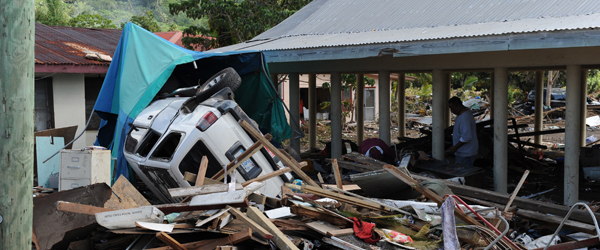 Before a Tsunami
Before a Tsunami
The following are things you can do to protect yourself, your family and your property from the effects of a tsunami:
- To begin preparing, you should build an emergency kit and make a family communications plan.
- Talk to everyone in your household about what to do if a tsunami occurs. Create and practice an evacuation plan for your family. Familiarity may save your life. Be able to follow your escape route at night and during inclement weather. You should be able to reach your safe location on foot within 15 minutes. Practicing your plan makes the appropriate response more of a reaction, requiring less thinking during an actual emergency.
- If the school evacuation plan requires you to pick your children up from school or from another location. Be aware telephone lines during a tsunami watch or warning may be overloaded and routes to and from schools may be jammed.
- Knowing your community's warning systems and disaster plans, including evacuation routes.
- Know the height of your street above sea level and the distance of your street from the coast or other high-risk waters. Evacuation orders may be based on these numbers.
- If you are a tourist, familiarize yourself with local tsunami evacuation protocols. You may be able to safely evacuate to the third floor and higher in reinforced concrete hotel structures.
- If an earthquake occurs and you are in a coastal area, turn on your radio to learn if there is a tsunami warning.
During a Tsunami
- Follow the evacuation order issued by authorities and evacuate immediately. Take your animals with you.
- Move inland to higher ground immediately. Pick areas 100 feet (30 meters) above sea level or go as far as 2 miles (3 kilometers) inland, away from the coastline. If you cannot get this high or far, go as high or far as you can. Every foot inland or upward may make a difference.
- Stay away from the beach. Never go down to the beach to watch a tsunami come in. If you can see the wave you are too close to escape it. CAUTION - If there is noticeable recession in water away from the shoreline this is nature's tsunami warning and it should be heeded. You should move away immediately.
- Save yourself - not your possessions.
- Remember to help your neighbors who may require special assistance - infants, elderly people, and individuals with access or functional needs.
After a Tsunami
- Return home only after local officials tell you it is safe. A tsunami is a series of waves that may continue for hours. Do not assume that after one wave the danger is over. The next wave may be larger than the first one.
- Go to a designated public shelter if you have been told to evacuate or you feel it is unsafe to remain in your home. Text SHELTER + your ZIP code to 43362 (4FEMA) to find the nearest shelter in your area (example: shelter 12345).
- Avoid disaster areas. Your presence might interfere with emergency response operations and put you at further risk from the residual effects of floods.
- Stay away from debris in the water; it may pose a safety hazard to people or pets.
- Check yourself for injuries and get first aid as needed before helping injured or trapped persons.
- If someone needs to be rescued, call professionals with the right equipment to help. Many people have been killed or injured trying to rescue others.
- Help people who require special assistance—infants, elderly people, those without transportation, people with access and functional needs and large families who may need additional help in an emergency situation.
- Continue using a NOAA Weather Radio or tuning to a Coast Guard station or a local radio or television station for the latest updates.
- Stay out of any building that has water around it. Tsunami water can cause floors to crack or walls to collapse.
- Use caution when re-entering buildings or homes. Tsunami-driven floodwater may have damaged buildings where you least expect it. Carefully watch every step you take.
- To avoid injury, wear protective clothing and be cautious when cleaning up.
Wildfires
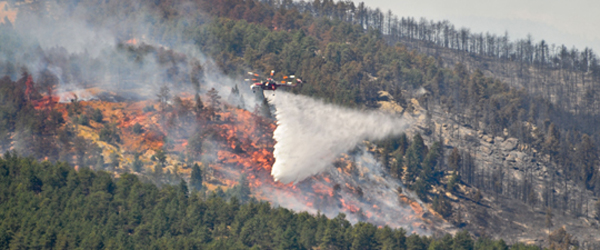 More and more people are making their homes in woodland settings - in or near forests, rural areas, or remote mountain sites. There, homeowners enjoy the beauty of the environment but face the very real danger of wildfire.
More and more people are making their homes in woodland settings - in or near forests, rural areas, or remote mountain sites. There, homeowners enjoy the beauty of the environment but face the very real danger of wildfire.
Every year across our Nation, some homes survive - while many others do not - after a major wildfire. Those that survive almost always do so because their owners had prepared for the eventuality of fire, which is an inescapable force of nature in fire-prone wildland areas. Said in another way - if it's predictable, it's preventable!
Wildfires often begin unnoticed. These fires are usually triggered by lightning or accidents. They spread quickly, igniting brush, trees, and homes. Reduce your risk by preparing now - before wildfire strikes. Meet with your family to decide what to do and where to go if wildfires threaten your area. Follow the steps listed below to protect your family, home, and property
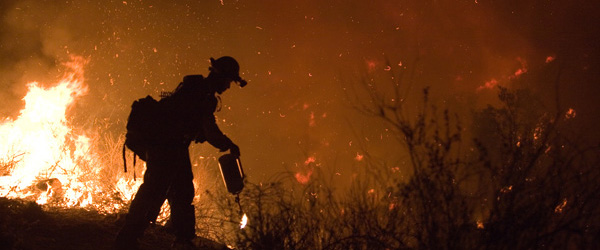 Before a Wildfire
Before a Wildfire
The following are things you can do to protect yourself, your family and your property in the event of a fire.
- To begin preparing, you should build an emergency kit and make a family communications plan.
- Design and landscape your home with wildfire safety in mind. Select materials and plants that can help contain fire rather than fuel it.
- Use fire-resistant or noncombustible materials on the roof and exterior structure of the dwelling, or treat wood or combustible material used in roofs, siding, decking or trim with fire-retardant chemicals evaluated by a nationally recognized laboratory, such as Underwriters Laboratories (UL).
- Plant fire-resistant shrubs and trees. For example, hardwood trees are less flammable than pine, evergreen, eucalyptus or fir trees.
- Regularly clean roof and gutters.
- Inspect chimneys at least twice a year. Clean them at least once a year. Keep the dampers in good working order. Equip chimneys and stovepipes with a spark arrester that meets the requirements of National Fire Protection Association Standard 211. (Contact your local fire department for exact specifications.)
- Use 1/8-inch mesh screen beneath porches, decks, floor areas, and the home itself. Also, screen openings to floors, roof and attic.
- Install a dual-sensor smoke alarm on each level of your home, especially near bedrooms; test monthly and change the batteries at least once each year.
- Teach each family member how to use a fire extinguisher (ABC type) and show them where it's kept.
- Keep handy household items that can be used as fire tools: a rake, axe, handsaw or chain saw, bucket and shovel.
- Keep a ladder that will reach the roof.
- Consider installing protective shutters or heavy fire-resistant drapes.
- Clear items that will burn from around the house, including wood piles, lawn furniture, barbecue grills, tarp coverings, etc. Move them outside of your defensible space.
Plan Your Water Needs
- Identify and maintain an adequate outside water source such as a small pond, cistern, well, swimming pool, or hydrant.
- Have a garden hose that is long enough to reach any area of the home and other structures on the property.
- Install freeze-proof exterior water outlets on at least two sides of the home and near other structures on the property. Install additional outlets at least 50 feet from the home.
- Consider obtaining a portable gasoline powered pump in case electrical power is cut off.
Your best resource for proper planning is www.firewise.org which has outstanding information used daily by residents, property owners, fire departments, community planners, builders, public policy officials, water authorities, architects and others to assure safety from fire - it really works. Firewise workshops are offered for free all across the nation in communities large and small and free Firewise materials can be obtained easily by anyone interested.
During a Wildfire
If you see a wildfire, call 9-1-1. Don't assume that someone else has already called. Describe the location of the fire, speak slowly and clearly, and answer any questions asked by the dispatcher.
- Arrange temporary housing at a friend or relative’s home outside the threatened area in case you need to evacuate.
- Wear protective clothing – sturdy shoes, cotton or woolen clothes, long pants, a long-sleeved shirt, gloves and a handkerchief to protect your face.
- Gather fire tools such as a rake, axe, handsaw or chainsaw, bucket and shovel.
- Close outside attic, eaves and basement vents, windows, doors, pet doors, etc. Remove flammable drapes and curtains. Close all shutters, blinds or heavy non-combustible window coverings to reduce radiant heat.
- Close all doors inside the house to prevent draft. Open the damper on your fireplace, but close the fireplace screen.
- Shut off any natural gas, propane or fuel oil supplies at the source.
- Connect garden hoses. Fill any pools, hot tubs, garbage cans, tubs or other large containers with water.
- Place lawn sprinklers on the roof and near above-ground fuel tanks. Wet the roof.
- If you have gas-powered pumps for water, make sure they are fueled and ready.
- Place a ladder against the house in clear view.
- Back your car into the driveway; shut the doors and roll up the windows. Leave the key in the ignition and the car doors unlocked.
- Disconnect any automatic garage door openers so that doors can still be opened by hand if the power goes out. Close all garage doors.
- Place valuable papers, mementos and anything "you can't live without" inside the car in the garage, ready for quick departure. Any pets still with you should also be put in the car.
- Place valuables that will not be damaged by water in a pool or pond.
- Move flammable furniture into the center of the residence away from the windows and sliding-glass doors.
- Turn on outside lights and leave a light on in every room to make the house more visible in heavy smoke.
- Leave doors and windows closed but unlocked. It may be necessary for firefighters to gain quick entry into your home to fight fire. The entire area will be isolated and patrolled by sheriff's deputies or police.
If advised to evacuate, do so immediately. Take your disaster supply kit, lock your home and choose a route away from the fire hazard. Watch for changes in the speed and direction of the fire and smoke. Tell someone when you left and where you are going.
After a Wildfire
The following are guidelines for different circumstances in the period following a fire:
- Go to a designated public shelter if you have been told to evacuate or you feel it is unsafe to remain in your home. Text SHELTER + your ZIP code to 43362 (4FEMA) to find the nearest shelter in your area (example: shelter 12345).
- If you are with burn victims, or are a burn victim yourself, call 9-1-1 or seek help immediately; cool and cover burns to reduce chance of further injury or infection.
- If you remained at home, check the roof immediately after the fire danger has passed. Put out any roof fires, sparks or embers. Check the attic for hidden burning sparks.
- For several hours after the fire, maintain a "fire watch." Re-check for smoke and sparks throughout the house.
- If you have evacuated, do not enter your home until fire officials say it is safe.
- If a building inspector has placed a color-coded sign on the home, do not enter it until you get more information, advice and instructions about what the sign means and whether it is safe to enter your home.
- If you must leave your home because a building inspector says the building is unsafe, ask someone you trust to watch the property during your absence.
- Use caution when entering burned areas as hazards may still exist, including hot spots, which can flare up without warning.
- If you detect heat or smoke when entering a damaged building, evacuate immediately.
- If you have a safe or strong box, do not try to open it. It can hold intense heat for several hours. If the door is opened before the box has cooled, the contents could burst into flames.
- Avoid damaged or fallen power lines, poles and downed wires.
- Watch for ash pits and mark them for safety—warn family and neighbors to keep clear of the pits also.
- Watch animals closely and keep them under your direct control. Hidden embers and hot spots could burn your pets’ paws or hooves.
- Follow public health guidance on safe cleanup of fire ash and safe use of masks.
- Wet debris down to minimize breathing dust particles.
- Wear leather gloves and heavy soled shoes to protect hands and feet.
- Cleaning products, paint, batteries and damaged fuel containers need to be disposed of properly to avoid risk.
- Discard any food that has been exposed to heat, smoke or soot.
- Do NOT use water that you think may be contaminated to wash dishes, brush teeth, prepare food, wash hands, make ice or make baby formula.
- Remain calm. Pace yourself. You may find yourself in the position of taking charge of other people. Listen carefully to what people are telling you, and deal patiently with urgent situations first.
No comments:
Post a Comment